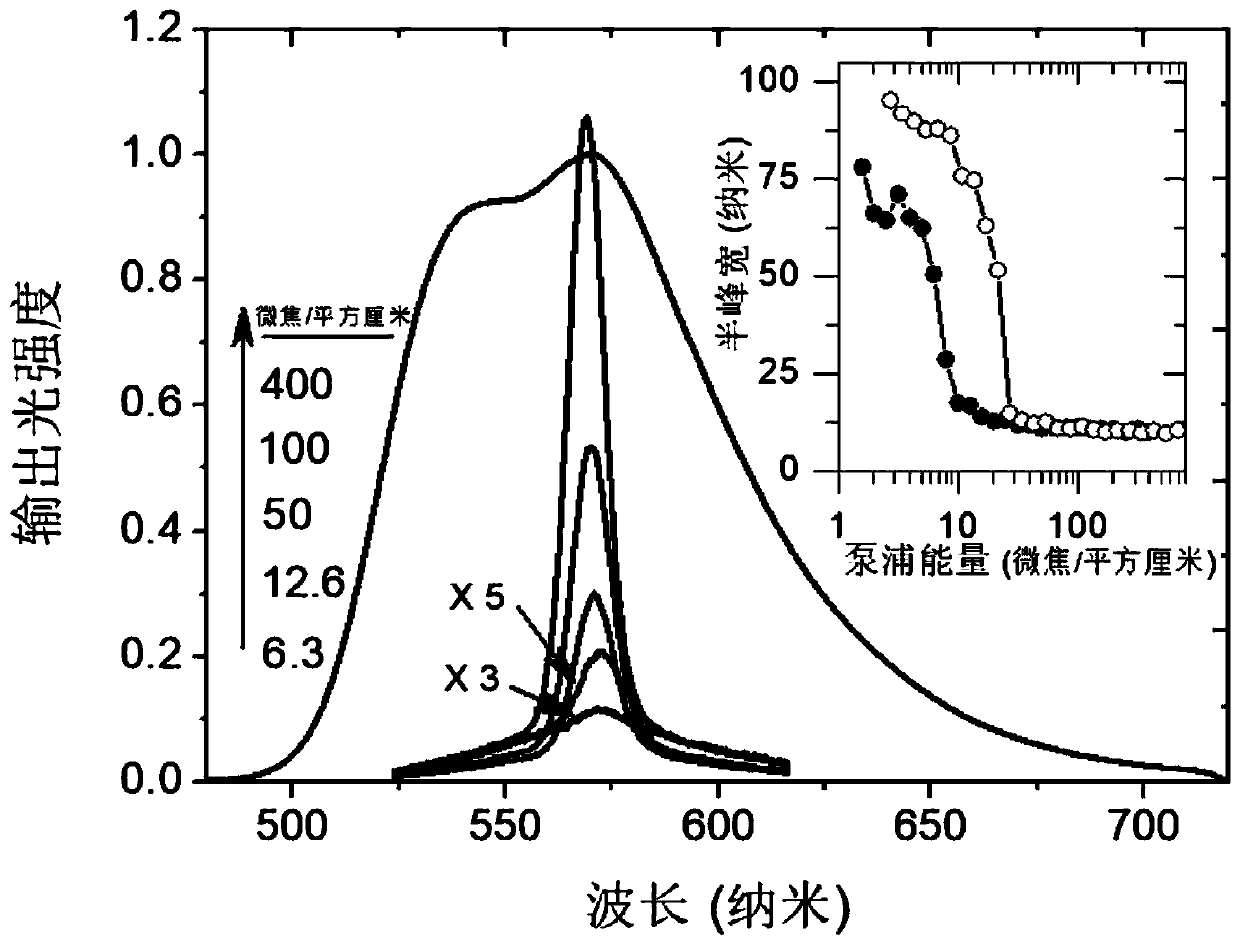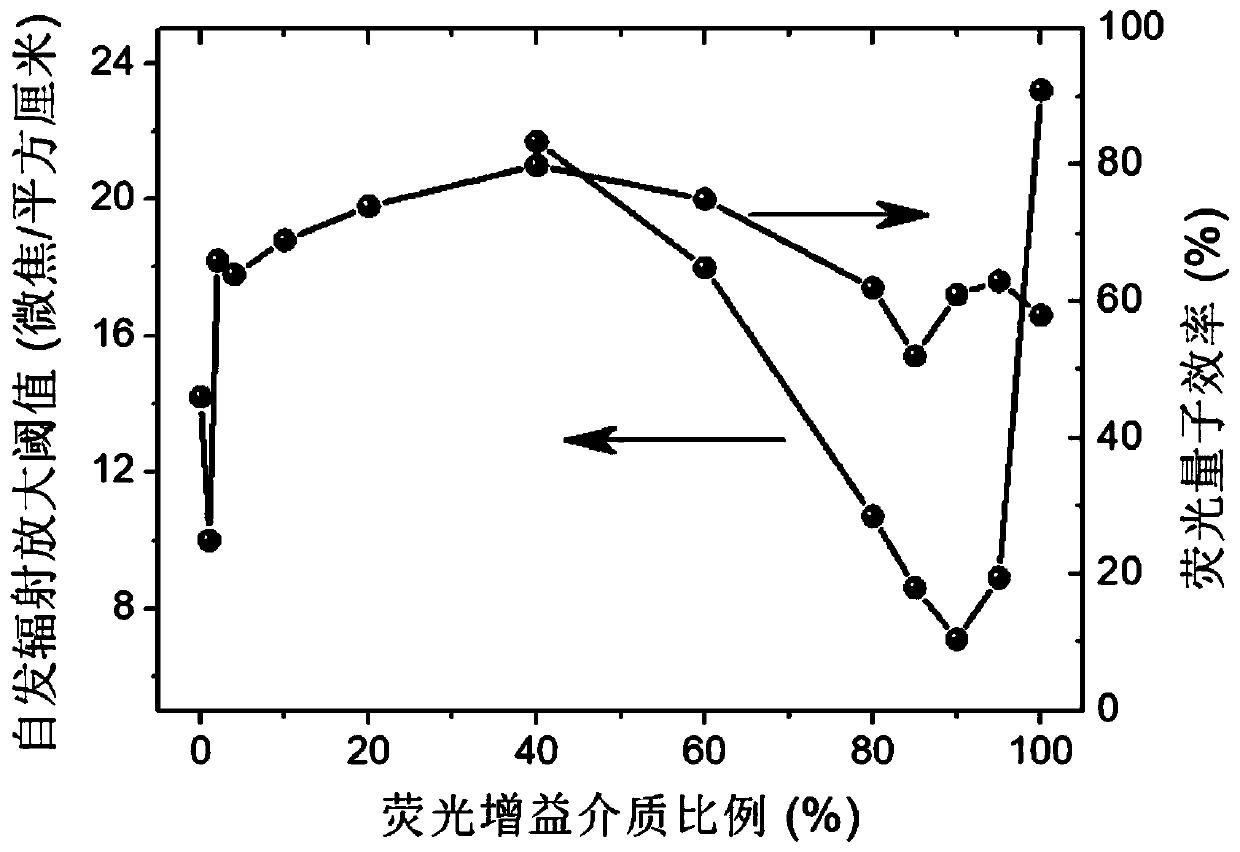An organic laser thin film device based on a triplet exciton amplifier and its application
A laser thin film and triplet technology, applied in the laser field, can solve the problems of large optical loss and waste, and achieve the effects of low cost, simple and fast preparation, and lowering of the pumping threshold.
- Summary
- Abstract
- Description
- Claims
- Application Information
AI Technical Summary
Problems solved by technology
Method used
Image
Examples
Embodiment 1
[0043] Choose a transparent quartz plate as the substrate, choose the gain medium of the triplet-singlet host-guest doping system, and choose the iridium complex (Dfpypy) as the host 2 Ir(pic), the object selective fluorescent gain medium F8BT, its structural formula is:
[0044]
[0045] The mass ratio of host and guest is: 1%, 2%, 4%, 10%, 20%, 40%, 60%, 80%, 85%, 90% and 95%, and the preparation method is shown in the specific embodiment. figure 2 Shown is (Dfpypy) 2 Spectra of organic laser thin film devices with a doping mass ratio of Ir(pic) to F8BT of 1:9 at different pump energies, it can be seen that as the pump energy increases, the spectrum narrows, that is, spontaneous Amplification of radiation (ASE) phenomenon; the inset is a comparison of the half-peak width of the pure F8BT output spectrum with the pump energy. It can be seen that the spontaneous emission amplification threshold of the doped organic laser thin film device is higher than that of the pure fl...
Embodiment 2
[0047] Choose a transparent quartz plate as the substrate, choose the gain medium of the triplet-singlet host-guest doping system, and choose the iridium complex (Dfpypy) as the host 2 Ir(dpm), guest selective fluorescent gain medium F8BT. The mass ratio of host and guest is: 1%, 2%, 4%, 10%, 20%, 40%, 60%, 80%, 85%, 90% and 95%, and the preparation method is shown in the specific embodiment. Figure 4 A comparison chart showing the variation of the spontaneous emission amplification threshold of the organic laser thin film devices of Example 1 and Example 2 with the proportion of the fluorescent gain medium. It can be seen that the selection of iridium complexes (Dfpypy) 2 The spontaneous emission amplification threshold of Example 2 in which Ir(dpm) is the main body is higher than that of Example 1.
Embodiment 3
[0049] Choose the glass-based DFB grating as the substrate, choose the gain medium of the triplet-singlet host-guest doping system, and choose the iridium complex (Dfpypy) as the host 2 Ir(pic), the guest-selective fluorescent gain medium F8BT. The mass ratio of the host to the guest is 90%, and the preparation method is as shown in the detailed description. Figure 5 Shown are the laser spectrum, fluorescence spectrum and laser threshold variation graph of the organic laser thin film device under different DFB grating periods. It can be seen that the organic laser thin film device with DFB grating as the substrate has obvious laser spectral output.
PUM
| Property | Measurement | Unit |
|---|---|---|
| internal quantum efficiency | aaaaa | aaaaa |
Abstract
Description
Claims
Application Information
 Login to View More
Login to View More - R&D
- Intellectual Property
- Life Sciences
- Materials
- Tech Scout
- Unparalleled Data Quality
- Higher Quality Content
- 60% Fewer Hallucinations
Browse by: Latest US Patents, China's latest patents, Technical Efficacy Thesaurus, Application Domain, Technology Topic, Popular Technical Reports.
© 2025 PatSnap. All rights reserved.Legal|Privacy policy|Modern Slavery Act Transparency Statement|Sitemap|About US| Contact US: help@patsnap.com



